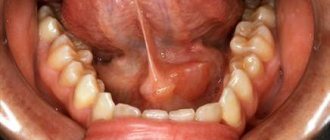It is a malignant neoplasm formed from stratified squamous epithelium located in the area of the red border of the lips. Squamous cell carcinoma can be keratinizing (Fig. 1) and non-keratinizing (Fig. 2). In the first case, the tumor grows slowly, outward (exophytic), and in rare cases spreads to other organs, tissues, and the lymphatic system. That is, it rarely metastasizes. Nonkeratinizing squamous cell carcinoma is more aggressive. It is characterized by: metastasis in particular cases, rapid growth, early appearance of ulcers, infiltrative growth (endophytic), infiltration of local tissues.
Picture 1
Figure 2
Causes of lip cancer
Why lip cancer develops, like other types of cancer, is still not known exactly. In most cases, this is preceded by one or another chronic process. The risk group consists of men over 40 years of age. In women, lip cancer occurs in 3-8% of the total number of cases.
Risk factors for this disease include:
- permanent mechanical injuries to the lip due to incorrect dentures, the sharp edge of a carious tooth, or a malocclusion;
- regularly recurring or chronic infection on the lip, for example, cheilitis of a viral or bacterial nature;
- smoking, excessive consumption of too hot food or alcohol;
- constant contact with harmful substances;
- constant hypothermia or overheating.
The hereditary factor is no less significant - if loved ones had a similar disease, then the person has an increased risk of developing it.
Treatment with folk remedies
As with any other malignant processes, under no circumstances should folk remedies be used to treat this disease. Such actions will lead to loss of precious time. Therefore, if you suspect the development of a tumor, you should immediately consult a doctor.
- During treatment, your doctor may recommend rinsing your mouth. For this purpose, decoctions of chamomile, oak bark, sage, and calendula are sometimes used.
- Sea buckthorn oil can be used to lubricate the mouth.
However, such measures can only be used after the recommendation of a doctor.
Symptoms
The entire process of development of cancer affecting the lips can be described as follows:
- lip tissue thickens;
- it progressively increases, ulceration appears in the center of the tumor;
- it becomes crusty on top, and raised ridges form along the edges of the ulcer.
It is these external symptoms that appear at the beginning and give reason to suspect malignant development. In most cases, the lump is localized away from the center and corners of the mouth - tumors rarely occur in these places.
In addition to external signs, the patient develops symptoms of a general deterioration of his condition:
- constant weakness;
- slight loss in body weight;
- decreased appetite;
- frequent headache;
- temperature up to 37.8 °C for a long time.
It is worth noting that general symptoms may be the only manifestation of the disease at the initial stage. Externally, the tumor may not yet show itself. And only with the progression of the disease external signs appear. They are also accompanied by other symptoms:
- pain in the affected area;
- severe itching of the skin;
- discomfort and pain when eating.
Signs and symptoms of oral and oropharyngeal cancer
If you have one or more of the following signs or symptoms for 2 weeks or more, you should immediately consult your doctor.
- The presence of a long-term non-healing ulcer in the mouth.
- Persistent pain in the mouth.
- Swelling or thickening of the cheek.
- White or red spots on the gums, tongue, tonsils, or lining of the mouth.
- Sensation of a foreign body in the throat.
- Difficulty chewing or swallowing.
- Difficulty moving the jaw or tongue.
- Numbness of the tongue.
- Voice change.
- The appearance of swelling in the neck.
- Weight loss.
- Long-term difficulty breathing
It should be noted that these changes are not necessarily related to cancer and may occur in a number of other non-tumor diseases. However, only a doctor can find out the cause of such changes.
Stages
The oncologist determines the stage of the disease. This is important for prescribing effective therapy. The stage of the disease must be indicated in the diagnosis. Let's look at the stages using the example of stage III squamous cell carcinoma of the lower lip (T2N1M0). Each sign in the designation has its own role. The letters TNM define the characteristics of a malignant tumor and the stage of cancer:
- T – Tumor, which means tumor size: T1 – no more than 2 cm, T2 – 2-4 cm, T3 – more than 4 cm, T4 – the tumor has grown into surrounding organs;
- N – Nodus. Indicates the degree of damage to the lymph nodes: N0 – lymph nodes are not affected, N1 – enlargement of nearby lymph nodes up to 3 cm, N2 – small lesions in several nodes or a large lesion in one, N3 – enlargement of several lymph nodes by more than 6 cm;
- M - Metastasis. Shows whether the lip tumor has caused the spread of metastases to other organs: M0 – no metastases, M – yes.
Leukoplakia, erythroplakia and dysplasia
Leukoplakia and erythroplakia are terms denoting various changes in the mucous membrane of the oral cavity and pharynx due to smoking, chewing tobacco, trauma to the oral mucosa with a denture
The appearance of a changed white mucous membrane may indicate the presence of leukoplakia in the patient. With erythroplakia, the altered mucous membrane is red in color, may protrude somewhat above the surface and bleed easily.
The severity of the resulting changes in the mucous membrane of the oral cavity and pharynx can only be clarified with the help of a biopsy (taking a piece of tissue for microscopic examination) or scraping of individual cells.
These changes may be harmless and disappear after the cessation of exposure to the causative factor, but may precede the onset of cancer.
This precancerous condition is called dysplasia.
There are minor, moderate and severe degrees of dysplasia. Knowing the degree of dysplasia, it is possible to predict (predict) the likelihood of self-healing, disappearing after treatment, or turning into a malignant tumor.
Without proper treatment, 5% of leukoplakia develop into cancer over a 10-year period.
Erythroplakia is a more serious condition in which almost 50% of cases are diagnosed as cancer after biopsy.
More than 90% of tumors of the oral cavity and oropharynx are squamous cell carcinoma, developing from integumentary (epithelial) cells.
Verrucous (warty) carcinoma is a type of squamous cell carcinoma and accounts for 5% of all oral tumors. This type of cancer is a low-grade tumor that rarely metastasizes, but can spread deeply into surrounding tissues. In this regard, wide removal of the tumor within healthy tissue is recommended.
The minor salivary glands, located in the oral and pharyngeal mucosa, can give rise to various types of cancer, such as adenoid cystic carcinoma, mucoepidermoid carcinoma and low-grade polymorphic adenocarcinoma.
The tonsils and base of the tongue contain lymphoid tissue from which lymphomas (non-Hodgkin's lymphoma/lymphosarcoma and Hodgkin's disease/lymphogranulomatosis) can develop.
Diagnostics
The specialist prescribes a series of laboratory and instrumental examinations to the patient. The tumor is visible to the naked eye, so a specialist can make a preliminary diagnosis during a consultation.
But seeing symptoms is not enough - you need to confirm them with examination results. They are also necessary to determine the extent of tumor spread. With the help of diagnostics, it is possible to identify the stages of lip cancer, which is important for prescribing adequate treatment. The doctor also needs to find out about the presence of metastases and damage to the lymph nodes.
The following diagnostic methods help determine the presence of cancer:
- cytology of a sample of cells from the suspicious area;
- blood test for tumor markers;
- MRI and CT of the neck and face;
- X-ray examination of the jaw;
- fluorescent diagnostics.
Prognostic factors
Prognosis (outcome) factors for lip cancer are:
- prevalence of the process (size of the primary tumor, presence of metastases);
- clinical and anatomical form of cancer growth (exophytic forms proceed more favorably);
- morphological type of cancer (the non-keratinizing type is more aggressive);
- nature of tumor growth (primary or recurrent);
- age (patients under 40 years of age have a more malignant course).
The prognosis for lip cancer is generally favorable.
A worsening prognosis is associated with locally widespread infiltrative growth and significant regional and distant metastasis.
Lip cancer treatment
Depending on the stage of lip cancer pathology identified during the diagnostic process, the doctor prescribes therapy. If metastases and lymph node damage are not observed, doctors limit themselves to local procedures using ultraviolet light, radiation or cold. Otherwise, you have to resort to chemotherapy and radiation therapy.
Chemotherapy
If the initial stage of lip cancer is successfully treated using surgery, then chemotherapy is more effective when the tumor spreads throughout the body. It is used as a temporary way to stop the progression of cancer. Chemotherapy helps when the lymph nodes are affected and there are metastases to other organs. It involves the intravenous administration of special drugs that have a toxic effect on cancer cells.
Surgical method
Using the cryosurgery method, you can significantly improve the prognosis of recovery and minimize the risk of symptoms of lip cancer in the future. The method consists of cooling the tissues and then excising them with a scalpel. Then they are immediately coagulated with an electric, argon plasma or other type of scalpel. The effectiveness of cold lies in the fact that it creates a boundary between pathological and healthy cells, which allows the doctor to remove the affected areas with high precision.
Radiation therapy
Even if the patient has an initial stage of lip cancer, this does not guarantee that the tumor will not begin to spread throughout the body. For this reason, surgery is often combined with radiation therapy. It allows you to destroy cells that may remain after the operation.
Radiation therapy completely destroys pathological lesions without affecting healthy tissue. This effect can be achieved through the use of targeted radioactive radiation.
What precedes cancer
The lips are muscles covered with tissue and skin, which is called the “red border”. The inner part, covered with the mucous membrane, anatomically belongs to the vestibule of the oral cavity, and tumors arising there are no longer considered labial. A malignant tumor of the lip can arise out of nowhere - practically out of nowhere, and since this disease is considered to belong to a not very socially prosperous population, cancer in this localization is often preceded by skin diseases of the red border of the lips. These pathological conditions are classified as precancerous, although not all of them become fertile ground for the development of a malignant process.
Precancerous processes are similar in appearance, but differ in cellular structure. Precancerous lips are characterized by hyperplasia - excessive cell growth, frequent cell division, however, within the strictly prescribed framework of nature, and not endlessly, as in a malignant process. Cells of irregular shape appear, prone to rapid keratinization, which is manifested by hyperkeratosis - scaly dry skin. All lip diseases are seriously treated surgically or with close-focus radiotherapy.
- Previously, Bowen's disease was classified as an obligate precancer - a condition that, if persisted for a long time, was highly likely to develop cancer. In reality, cancer develops at the site of this “sore” in approximately every sixth patient. Today the disease is already considered cancer in situ - stage 0 cancer. With Bowen's disease, a spot with small nodules and papillae, velvety or smooth, sometimes with superficial ulcers - erosions, lives and grows on the lip for a long time.
- Erythroplasia Keira, a bright red lump with clear contours that rises above the skin, is no less likely to become a cause for the development of lip cancer. Over time, the lump ulcerates and is also considered stage 0 cancer.
- Manganotti's abrasive cheilitis is a pathology in which most often polished erosions with raised edges appear in the center, become covered with crusts and even heal on their own, but certainly recur.
- In young men, a bulging area with white scales surrounded by inflamed tissue may appear on the lower lip - this is limited hyperkeratosis of the red border of the lips.
- The lip is also affected by a variety of leukoplakia, often with small warts, plaques and erosions, which threatens every fourth patient with lip cancer.
- Keratoacanthoma is a semicircular fat cyst covered with scales, with a depression in the center similar to a volcanic crater. The pathology affects the lower lip, as a rule, of rural men, and in the elderly it is single, and in the young it consists of several nodules.
Treatment under a medical policy
You can receive FREE medical care at the Oncology Center under the State Guarantee Program of Compulsory Medical Insurance (Compulsory Medical Insurance) and High-Tech Medical Care.
The service is valid for all Russian citizens.
To find out more details, as well as for what nosologies and services this program works, please call +7, or you can read in more detail here.
The multidisciplinary oncology clinic “Sofia” gives patients the opportunity to undergo a course of therapy within the framework of the compulsory medical insurance policy. This is a special quota program that provides free medical services financed from federal and local budgets. Within its framework the following can be performed:
- PET/CT;
- radiation therapy;
- chemotherapy;
- IHC;
- surgery.
Medical services under compulsory medical insurance are available to all citizens of Russia. First of all, patients with a diagnosis that poses a serious threat to their life can count on free therapy.
By contacting us for medical assistance under compulsory medical insurance, you can significantly shorten the path to obtaining a quota. Our therapist or oncologist will prepare a statement with a confirmed diagnosis and the results of earlier studies. This document must be submitted to the regional health authority along with:
- an application for cancer treatment under the compulsory medical insurance policy;
- Russian passport and insurance policy;
- SNILS;
- consent to the processing of personal data;
- pension certificate (for pensioners).
Methods for diagnosing cancer of the oral cavity and oropharynx
During the conversation, the doctor will ask you about the symptoms that have appeared, risk factors and previous diseases. After this, he will examine the head, neck, oral cavity, and palpate the lymph nodes.
If necessary, an otolaryngologist, a specialist in diseases of the ear, nose and throat, will be called and may prescribe additional examination.
Nasopharyngoscopy, pharyngoscopy, laryngoscopy (examination, respectively, of the nasal cavity, pharynx and larynx) using a mirror or a special instrument allows you to examine these areas and, if necessary, do a biopsy (taking a piece of tissue for examination).
To confirm the diagnosis of a tumor, material can be obtained by scraping in the area of a suspicious area, puncture with a thin needle, or surgical removal of part of the tumor.
A peripheral blood test allows you to assess the general condition of the patient and detect anemia (anemia), and a biochemical blood test can suspect liver and bone damage.
Chest X-ray makes it possible to detect damage to the lung tissue, which is rare, but possible with a widespread tumor process.
Computed tomography (CT), sometimes with additional contrast, can help determine the size, shape, and location of the tumor, as well as the presence of enlarged lymph nodes.
Magnetic resonance imaging (MRI) provides additional information to CT, especially regarding the spinal cord and brain.
Positron emission tomography (PET) scans use radioactive glucose that accumulates in tumor cells. This method is especially useful for identifying affected lymph nodes.
Benefits of onco
For more than 30 years, onco has been working for the health and comfort of patients with oncology. During this time, we have developed an ideal efficiency formula, which includes:
- maximum safety;
- exact compliance with domestic and international standards and protocols;
- experienced and competent oncologists, diagnosticians, laboratory technicians and consultants;
- modern and high-tech medical equipment;
- uncompromising comfort and support for patients at every stage of therapy.
The high level of service and quality of services has been repeatedly confirmed by numerous certificates and awards. Most of the doctors working for us have trained in medical institutions in the USA and Europe, learning from the invaluable experience of their foreign colleagues.
In our work, we achieve amazing results not only thanks to modern equipment and a staff of true professionals. Our patients feel safe and comfortable, as all rooms of the oncology center are beautifully designed. The furnishings and interior are imbued with a favorable atmosphere, far from a hospital one. Also available to patients and those accompanying them is a pharmacy, a cozy cafe and a rooftop restaurant with panoramic views.
Two onco buildings have extensive territories; The buildings themselves house many offices, departments and treatment rooms. To prevent you from getting lost, our employee will guide you to the right door. Finding a place for your car will also not be a problem: we have a large parking lot.
Types of skin cancer
There are 3 types of common malignant skin tumors. They differ both in incidence (i.e., the chance of getting sick) and in the degree of danger to life - basal cell carcinoma, squamous cell carcinoma and melanoma.
Melanoma is one of the rare and dangerous skin tumors. It accounts for only 4% of the total number of malignant skin tumors, but is the cause of almost 80% of deaths in this localization. You can read more about melanoma here.
Sign up for the webinar “Carcinogens in cosmetics: truth, lies and... marketing”
Make an appointment
Do not delay your visit to a specialist - the sooner the disease is detected, the higher the chances of a full recovery. Onco works on weekends and holidays, so you can schedule a consultation at any time. To do this, use the method most convenient for you:
- call us at our contact number;
- use the online form on the website.
We are located at 2nd Tverskoy-Yamskaya lane, 10, not far from the metro stations “Belorusskaya”, “Novoslobodskaya”, “Mayakovskaya”, “Mendeleevskaya” and “Chekhovskaya”.
Staging oral and oropharyngeal cancer
Carrying out a comprehensive examination makes it possible to identify the extent of the tumor process and determine the stage of the tumor - from 0 to IV.
Stage 0 means the earliest phase of cancer development, when the tumor has not yet spread beyond the mucous membrane of the oral cavity or oropharynx.
Increasing stages indicate a greater prevalence of the process. Stage IV refers to involvement of organs distant from the primary tumor.
Cancer recurrence means the return of the disease in the area of the primary location of the tumor or at a distance from the main focus.







